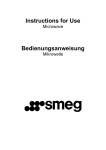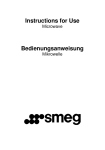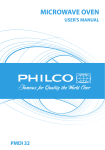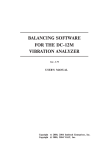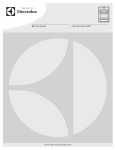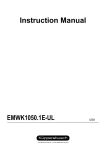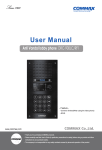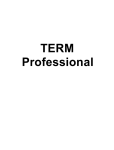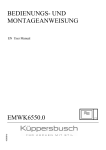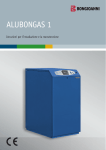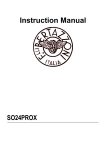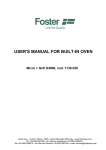Download Electrolux EMT38409AX microwave
Transcript
EMT 38409 EN Microwave Instruction Manual 2 2 WWW.ELECTROLUX.COM CONTENTS INSTALLATION INSTRUCTIONS ........................................................................................3 MICROWAVE SAFETY ........................................................................................................4 THE ADVANTAGES OF MICROWAVES .............................................................................6 DESCRIPTION OF YOUR OVEN.........................................................................................7 BASIC CONTROLS ..............................................................................................................9 MAIN FUNCTION ...............................................................................................................11 SPECIAL FUNCTIONS ......................................................................................................16 WHEN THE OVEN IS WORKING... ................................................................................... 19 DEFROSTING .................................................................................................................... 20 COOKING WITH THE MICROWAVE OVEN ......................................................................21 COOKING WITH THE GRILL ............................................................................................. 24 ROASTING AND BAKING ..................................................................................................26 WHAT KIND OF OVENWARE CAN BE USED? ................................................................ 28 OVEN CLEANING AND MAINTENANCE ..........................................................................30 WHAT SHOULD I DO IF THE OVEN DOESN’T WORK? .................................................. 31 TECHNICAL CHARACTERISTICS .................................................................................... 33 ENVIRONMENT CONCERNS ........................................................................................... 33 INSTALLATION .................................................................................................................. 34 WE'RE THINKING OF YOU Thank you for purchasing an Electrolux appliance. You’ve chosen a product that brings with it decades of professional experience and innovation. Ingenious and stylish, it has been designed with you in mind. So whenever you use it, you can be safe in the knowledge that you’ll get great results every time. Welcome to Electrolux. Visit our website to: Get usage advice, brochures, trouble shooter, service information: www.electrolux.com Register your product for better service: www.electrolux.com/productregistration Buy Accessories, Consumables and Original spare parts for your appliance: www.electrolux.com/shop CUSTOMER CARE AND SERVICE We recommend the use of original spare parts. When contacting Service, ensure that you have the following data available. The information can be found on the rating plate. Model, PNC, Serial Number. Warning / Caution-Safety information. General information and tips. Environmental information. Subject to change without notice. ENGLISH 3 INSTALLATION INSTRUCTIONS BEFORE INSTALLATION Check that the input voltage indicated on the characteristics plate is the same as the voltage of the power outlet you are going to use. Open the oven door and take out all the accessories and remove the packing material. Do not remove the mica cover on the ceiling of the interior! This cover stops fat and pieces of food damaging the microwave generator. WARNING! The front surface of the oven may be wrapped with a protective film. Before using the oven for the first time, carefully remove this film, starting on the inside. Make sure that the oven is not damaged in any way. Check that the oven door closes correctly and that the interior of the door and the front of the oven opening are not damaged. If you find any damage contact the Technical Assistance Service. DO NOT USE THE OVEN if the power cable or the plug are damaged, if the oven does not function correctly or if it has been damaged or dropped, contact the Technical Assistance Service. Put the oven on a flat and stable surface. The oven must not be put close to any sources of heat, radios or televisions. During installation, make sure that the power cable does not come into contact with any moisture or objects with sharp edges behind the oven. High temperatures can damage the cable. AFTER INSTALLATION The oven is equipped with a power cable and a plug for single phase current. If the oven is to be installed on a permanent basis it should be installed by a qualified technician. In such a case, the oven should be connected to a circuit with an all-pole circuit breaker with a minimum separation of 3 mm between contacts. WARNING: THE OVEN MUST BE EARTHED. The manufacturer and retailers do not accept responsibility for any damage that may be caused to people, animals or property if these installation instructions are not observed. The oven only functions when the door is closed correctly. After the first use, clean the inside of the oven and the accessories, following the cleaning instructions given in the section “Oven cleaning and maintenance”. Fit the Turntable support in the centre of the oven cavity and put the Turntable ring and the Turntable plate on top, making sure they slot in. Whenever you use the microwave, the turntable plate and the respective accessories must be inside and correctly fitted. The turntable plate can rotate in both directions. During installation, follow the instructions supplied separately. 4 ENGLISH MICROWAVE SAFETY WARNING! Never leave the oven unwatched, especially when using paper, plastic or other combustible materials. These materials can char and may fire. FIRE RISK! WARNING! If you see smoke or fire, keep the door closed in order to smother the flames. Switch off the oven and take the plug out of the socket or cut off the oven power supply. WARNING! Do not heat pure alcohol or alcoholic drinks in the microwave. FIRE RISK! WARNING! Do not heat liquids or other foods in closed containers since these may explode readily. WARNING! This appliance is not intended for use by persons (including children) with reduced physical, sensory or mental capabilities, or lack of experience and knowledge, unless they have been given supervision or instruction concerning use of the appliance by a person responsible for their safety. Children should be supervised to ensure that they do not play with the appliance. WARNING! If the oven has a combined function mode (microwave with other means of heating), children should not be allowed to use the oven without adult supervision on account of the high temperatures generated. WARNING! The oven cannot be used if: The door is not closed correctly; The door hinges are damaged; The surfaces of the contact between the door and the oven front are damaged; The door window glass is damaged; There is frequent electrical arcing inside the oven even though there is no metal object inside. The oven can only be used again after it has been repaired by a Technical Assistance Service technician. BEWARE! Never heat baby foods or drinks in bottles or jars with the teats or lids on them. After heating the food mix or shake well so that the heat is spread evenly. Check the food temperature before feeding this to the child. DANGER OF BURNING! To avoid food overheating or burning it is very important not to select long time periods or power levels that are too high when heating small quantities of food. For example, a bread roll can burn after 3 minutes if the power selected is too high. For toasting, use just the grilling function and watch the oven all the time. It you use a combined function to toast bread it will catch fire in a very short time. Make sure you never catch the power cables of other electrical appliances in the hot door or the oven. The cable insulation may melt. Danger of shortcircuiting! TAKE CARE WHEN HEATING LIQUIDS! When liquids (water, coffee, tea, milk, etc.) are nearly at boiling point inside the oven and are taken out suddenly, they may spurt out of their containers. DANGER OF INJURIES AND BURNS! To avoid that type of situation when heating liquids, put a teaspoon or glass rod inside the container. The spoon cannot come in contact with the cavity walls - minimum distance 3 cm. ENGLISH 5 This oven is exclusively for domestic use! Use the oven only for preparing meals. Avoid damaging the oven or other dangerous situations by following these instructions: Do not switch on the oven without the turntable support, the turntable ring and the respective plate being in place. Never switch on the microwave when it is empty. If there is no food inside there may be an electrical overcharge and the oven could be damaged. RISK OF DAMAGE! For carrying out oven programming tests put a glass of water inside the oven. The water will absorb the microwaves and the oven will not be damaged. Do not cover or obstruct the ventilation openings. Use only dishes suitable for microwaves. Before using dishes and containers in the microwave, check that these are suitable (see the section on types of dishes). Never remove the mica cover on the ceiling of the oven interior! This cover stops fat and pieces of food damaging the microwave generator. Do not keep any inflammable object inside the oven as it may burn if the oven is switched on. Do not use the oven as a pantry. Eggs with their shells and whole boiled eggs must not be heated in microwave ovens because they may explode. Do not use the oven for frying as it is impossible to control the temperature of oil heated by microwaves. To avoid being burnt, always use oven gloves for handling dishes and containers and touching the oven. Do not lean or sit on the open oven door. This may damage the oven, especially in the hinge zone. The door can bear a maximum weight of 8 kg. The turntable and the grills can bear a maximum load of 8 kg. To avoid damaging the oven, do not exceed this load. WARNING! CLEANING: Your microwave oven must be cleaned regularly. All food remains must be removed (see section on Oven Cleaning). If the microwave oven is not kept clean its surface may deteriorate and this may shorten the oven’s working life and could even result in a dangerous situation. The door contact surfaces (the front of the cavity and the inside part of the doors) must be kept very clean in order to ensure the oven functions correctly. Please follow the instructions regarding cleaning in the section “Oven Cleaning and Maintenance”. WARNING! REPAIRS: The outer protection of the oven must not be removed. It is dangerous for anyone not authorised by the manufacturer to carry out any kind of repair or maintenance work. If the power cable is damaged it should be substituted by the manufacturer, authorised agents or technicians qualified for this task in order to avoid dangerous situations. Furthermore, special tools are required for this task.Repair and maintenance work, especially of current carrying parts, can only be carried out by technicians authorised by the manufacturer. 6 ENGLISH THE ADVANTAGES OF MICROWAVES In conventional ovens, heat radiated by electrical elements or gas burners slowly penetrates the food from outside to inside. On account of this there is a major amount of energy is wasted heating the air, the oven components and the food containers. In a microwave oven, heat is generated by the food itself and the heat travels from inside to outside. No heat is lost to the air, the walls of the oven cavity or the dishes and containers (if these are suitable for use in microwave oven), in other words, only the food is heated. Microwave ovens have the following advantages: Shorter cooking times; in general these are up to 3/4 less than the time required for conventional cooking. Ultra-fast food defrosting thus reduces the danger of bacterial development. Energy savings. Conservation of the nutritional value of foods due to the shorter cooking times. Easy to clean. How a microwave oven works? In a microwave oven there is a high tension valve called a magnetron which converts electrical energy into microwave energy. These electromagnetic waves are channelled to the interior of the oven through a wave guide and distributed by a metallic spreader or through a turntable. Inside the oven the microwaves propagate in all directions and are reflected by the metal walls, uniformly penetrating the food. Why food heats up Most foods contain water and water molecules vibrate when subjected to microwaves. The friction between molecules produces heat which raises the temperature of the food, defrosting it, cooking it or keeping it hot. Since the heat arises inside the food: This can be cooked with little or no liquid or fats/oils; Defrosting, heating or cooking in a microwave oven is quicker than in a conventional oven; The vitamins, minerals and nutritional substances in the food are conserved; The natural colour and aroma of the food are unchanged. Microwaves pass through china, glass, cardboard or plastic but do not go through metal. For this reason, metal containers or ones with metal parts must not be used in a microwave oven. Microwaves are reflected by metal... ... but go through glass and china... ... and are absorbed by foods. ENGLISH 7 DESCRIPTION OF YOUR OVEN 10 1 3 9 5 8 2 4 7 6 Control panel Turntable support Door window glass Turntable ring Lateral supports Turntable plate Catches Rectangular Glass Tray Hot Air Output Rectangular Rack Confimation key (OK) Cancel / Safety Block key Start / Quick Start key Temperature Light Parameter selection keys Minus and Plus keys Function Lights Clock/Duration Lights Function selection keys Power/Weight Lights 8 ENGLISH FUNCTION DESCRIPTION Symbol Function Microwave Power Output 200 400 Microwave Grill Microwave + Grill Hot-Air Microwaves + Hot-Air Grill + Fan Foods Slow defrosting for delicate foods; keeping food hot Cooking with little heat; boiling rice Rapid defrosting, heating baby food 600 Heating and cooking food 800 Cooking vegetables and food Cooking and heating carefully, Heating and cooking small portions of food 1000 Rapidly heating liquids --- Grilling food 200 Toasting food 400 Grilling poultry and meat 600 Cooking pies and cheese-topped dishes --600 --- Roasting and baking Quick meat, fish and poultry roasting. Baking cakes Grilling meat and fish Grilling poultry Potatoes – deep-frozen, defrosting and roasting ENGLISH 9 BASIC CONTROLS SETTING THE CLOCK The clock display will flash to indicate that the time shown is not correct. To set the clock, proceed as follows: 1. Select the Clock Symbol with the Parameter selection keys (not necessary if your microwave oven is first plugged in or after a power failure) “3”. 2. Set the hours with Plus and Minus keys “4”. 3. Confirm the selection with the Confirmation key “1”. 4. Set the minutes with the Plus and Minus keys “4”. 5. Confirm the selection with the Confirmation key “1”. HIDING/DISPLAYING THE CLOCK If the clock display disturbs you, you can hide it by proceeding as follows: 1. Press and hold the Confirmation key “1” for 3 seconds. The clock will be hidden but the dots between the hours and the minutes will flash once per second. 2. To show the clock again, repeat the described procedure again. 10 ENGLISH SAFETY BLOCKING The oven functioning can be blocked (for example, to stop it being used by children). Proceed as follows: 1. To block the oven, press the Cancel key “6” for 3 seconds. You will hear a sound signal and the clock display will show the word “SAFE”. The oven is blocked in this state and cannot be used. 2. To unblock the oven, press the Cancel key “6” again for 3 seconds. You will hear a sound signal and the clock display will show the time again. STOPPING THE ROTATING PLATE 1. To stop the rotating plate, press Confirmation “1” and “6” Cancel keys for 3 seconds to get the word “PLAT OFF” in the display. 2. To start plate rotation again, repeat the above procedure. Note: Make sure that you press the Confirmation key before theCancel key. ENGLISH 11 MAIN FUNCTION MICROWAVE Use this function to cook and heat vegetables, potatoes, rice, fish and meat. 1. Select the Microwave function with the Function selection keys “5” 2. Select the Power Level with Parameter selection keys “3”. The Power Level symbol and display start blinking. If you do not change the power level the microwave operates with the default power 800 W. 3. Set the power level with the Plus and Minus keys “4”. 4. Press the Confirmation key “1” to validate the power level. The display and symbol stop blinking. 5. Select the Duration with Parameter selection keys “3”. The Duration symbol and display start blinking. 6. Set the duration with the Plus and Minus keys “4”. 7. Press the Confirmation key “1” to validate the duration. The display and symbol stop blinking. 8. Start the cooking process by pressing the Start key “2” . NOTE: When 1000 W power is selected, the duration is limited to a maximum of 15 minutes. MICROWAVE – QUICK START Use this function to rapidly heat foods with high water content, such as water, coffee, tea or thin soup. 1. Press the Start key “2”. The microwave oven operates for 30 seconds at maximum power. 2. If you want to increase the operating time press the Start key “2” again. Each time you press this key the operating time will be increased by 30 seconds. NOTE: When 1000 W power is selected, the duration is limited to a maximum of 15 minutes 12 ENGLISH GRILL Use this function to brown the top of food quickly. 1. Select the Grill function with the Function selection keys “5” 2. Select the Duration with Parameter selection keys “3”. The Duration symbol and display start blinking. 3. Set the duration with the Plus and Minus keys “4”. 4. Press the Confirmation key “1” to validate the duration. The display and symbol stop blinking. 5. Start the cooking process by pressing the Start key “2”. MICROWAVE + GRILL Use this function to cook lasagne, poultry, roast potatoes and toasted foods. 1. Select the Microwave + Grill function with the Function selection keys “5”. 2. Select the Power Level with Parameter selection keys “3”. The Power Level symbol and display start blinking. If you do not change the power level the microwave operates with the default power 600 W. 3. Set the power level with the Plus and Minus keys “4” 4. Press the Confirmation key “1” to 5. 6. 7. 8. validate the power level. The display and symbol stop blinking. Select the Duration with Parameter selection keys “3”. The Duration symbol and display start blinking. Set the duration with the Plus and Minus keys “4”. Press the Confirmation key “1” to validate the duration. The display and symbol stop blinking. Start the cooking process by pressing the Start key “2”. ENGLISH 13 HOT AIR Use this function to bake and roast. 1. Select the Hot-Air function with the Function selection keys “5”. 2. Select the Temperature with Parameter selection keys “3”. The Temperature symbol and display start blinking. If you do not change the temperature the oven operates with the default temperature 160ºC. 3. Set the temperature with the Plus and Minus keys “4”. 4. Press the Confirmation key “1” to validate the temperature. The display and symbol stop blinking. 5. Select the Duration with Parameter selection keys “3”. The Duration symbol and display start blinking. 6. Set the duration with the Plus and Minus keys “4”. 7. Press the Confirmation key “1” to validate the duration. The display and symbol stop blinking. 8. Start the cooking process by pressing the Start key “2”. MICROWAVE + HOT AIR Use this function to bake and roast. 1. Select the Hot-Air + Microwaves function with the Function selection keys “5”. 2. Select the Temperature with Parameter selection keys “3”. The Temperature symbol and display start blinking. If you do not change the temperature the oven operates with the default temperature 160ºC. 3. Set the temperature with the Plus and Minus keys “4”. 4. Press the Confirmation key “1” to validate the temperature. The display and symbol stop blinking. 5. Select the Power Level with Parameter selection keys “3”. The Power Level symbol and display start blinking. If you do not change the power level the microwave operates with the default power 600 W. 6. Set the power level with the Plus and Minus keys “4”. 7. Press the Confirmation key “1” to validate the power level. The display and symbol stop blinking. 8. Select the Duration with Parameter selection keys “3”. The Duration symbol and display start blinking. 14 ENGLISH 9. Set the duration with the Plus and Minus keys “4”. 10. Press the Confirmation key “1” to validate the duration. The display and symbol stop blinking. 11. Start the cooking process by pressing the Start key “2”. GRILL WITH FAN Use this function for crispy roast meat, fish, poultry or French fries. 1. Select the Grill with Fan function with the Function selection keys “5”. 2. Select the Temperature with Parameter selection keys “3”. The Temperature symbol and display start blinking. If you do not change the temperature the oven operates with the default temperature 160ºC. 3. Set the temperature with the Plus and Minus keys “4”. 4. Press the Confirmation key “1” to validate the temperature. The display and symbol stop blinking. 5. Select the Duration with Parameter selection keys “3”. The Duration symbol and display start blinking. 6. Set the duration with the Plus and Minus keys “4”. 7. Press the Confirmation key “1” to validate the duration. The display and symbol stop blinking. 8. Start the cooking process by pressing the Start key “2”. DEFROSTING BY WEIGHT (AUTOMATIC) Use this function to defrost meat, poultry, fish, fruit and bread quickly. 1. Select the Defrost by Weight function with the Function selection keys “5”. 2. Select the Program with Parameter selection keys “3”. The Duration and Clock symbols and the display start blinking. 3. Set the program with the Plus and Minus keys “4” (refer to the table below). 4. Press the Confirmation key “1” to validate the program. The display and symbols stop blinking. ENGLISH 15 5. Select the Weight with Parameter selection keys “3”. The Weight symbol and display start blinking. 6. Set the weight with the Plus and Minus keys “4”. The following table shows the defrosting by weight function programmes, indicating weight Programm Food Weight (g) Pr 01 Meat 100 – 2000 Pr 02 Poultry 100 – 2500 Pr 03 Fish 100 – 2000 Pr 04 Fruit 100 – 500 Pr 05 Bread 100 – 800 7. Press the Confirmation key “1” to validate the weight. The display and symbol stop blinking. 8. Start the cooking process by pressing the Start key “2” intervals, and defrosting and standing times (in order to ensure the food is of a uniform temperature). Time (min.) 2 – 43 2 – 58 2 – 40 2 – 13 2 – 19 Standing time (min.) 20 – 30 20 – 30 20 – 30 10 – 20 10 – 20 Important Note: see “General instructions for defrosting“ DEFROSTING BY TIME (MANUAL) Use this function to defrost meat, poultry, fish, fruit and bread quickly. 1. Select the Defrost by Time function with the Function selection keys “5”. 2. Select the Duration with Parameter selection keys “3”. The Duration symbol and display start blinking. 3. Set the duration with the Plus and Minus keys “4”. 4. Press the Confirmation key “1” to validate the duration. The display and symbol stop blinking. 5. Start the cooking process by pressing the Start key “2”. 16 ENGLISH SPECIAL FUNCTIONS SPECIAL FUNCTION F1: HEATING FOOD Use this function to heat various types of food. 1. Select the Special function F1 with the Function selection keys “5”. 2. Select the Program with Parameter selection keys “3”. The Duration and Clock symbols and the display start blinking. 3. Set the program with the Plus and Minus keys “4”(refer to the table below). 4. Press the Confirmation key “1” to validate the program. The display and symbols stop blinking. The following table shows the Special Function F1 programmes, indicating weight intervals, and defrosting and 5. Select the Weight with Parameter selection keys “3”. The Weight symbol and display start blinking. 6. Set the weight with the Plus and Minus keys “4”. 7. Press the Confirmation key “1” to validate the weight. The display and symbol stop blinking. 8. Start the cooking process by pressing the Start key “2”. standing times (in order to ensure the food is of a uniform temperature). Weight Time Note (g) (min.) 200 – Turn1-2x, keep F1 A Soup 3 – 15 1500 covered, 1-2 min Pre-prepared dishes 200 – Turn1-2x, keep F1 B 3 – 20 dense food 1500 covered, 1-2 min Pre-prepared dishes 200 – Turn1-2x, keep F1 C 3 – 18 e.g. goulash 1500 covered, 1-2 min 200 – Turn1-2x, keep F1 D Vegetables 2,6 – 14 1500 covered, 1-2 min will take longer to heat up than food IMPORTANT NOTES: that is at room temperature. If the food temperature is not what is Always use dishes for use in the wanted, select a greater or lesser microwave oven and a lid or cover to weight next time you heat up the avoid loss of liquids. food. Stir or mix the foods several times After heating, stir the food or shake the during heating, especially when the container and then leave the food to oven emits a beep and the display is stand for some time to allow the flashing as follows: . temperature to become uniform The time required to heat the food throughout the food. will depend on its initial temperature. Food taken straight from the fridge Programm Food ENGLISH 17 WARNING! After heating the container may be very hot. Although microwaves do not heat up most containers, these may heat up through heat transmission from food. SPECIAL FUNCTION F2: COOKING Use this function to cook fresh food. 1. Select the Special function F2 with the Function selection keys “5”. 2. Select the Program with Parameter selection keys “3”. The Duration and Clock symbols and the display start blinking. 3. Set the program with the Plus and Minus keys “4” (refer to the table below). 4. Press the Confirmation key “1” to validate the program. The display and symbols stop blinking. The following table shows the Special Function F2 programmes, indicating weight intervals, and defrosting and Programm Food Weight (g) F2 A F2 B Potatoes Vegetables 200 – 1000 200 – 1000 F2 C Rice 200 – 500 F2 D Fish 200 – 1000 IMPORTANT NOTE: Always use dishes for use in the microwave oven and a lid or cover to avoid loss of liquids. Stir or mix the foods several times during heating, especially when the oven emits a beep and the display is flashing as follows: WARNING! 5. Select the Weight with Parameter selection keys “3”. The Weight symbol and display start blinking. 6. Set the weight with the Plus and Minus keys “4”. 7. Press the Confirmation key “1” to validate the weight. The display and symbol stop blinking. 8. Start the cooking process by pressing the Start key “2”. standing times (in order to ensure the food is of a uniform temperature). Time (Min.) 4 – 17 4 – 15 Note Turn 1 – 2 x keep covered Turn 1 – 2 x keep covered One part rice, two parts 13 – 20 water, keep covered 4 – 13 Keep covered After heating, the container may be very hot. Although microwaves do not heat up most containers, these may heat up through heat transmission from food. Preparation instructions: Fish pieces – Add 1 to 3 soup spoons of water or lemon juice. Rice – Add water equivalent to twice or three times the quantity of rice. 18 ENGLISH Unpeeled potatoes – Use potatoes of the same size. Wash them and prick the skin several times. Do not add water. Peeled potatoes and Fresh vegetables – Cut into pieces of the same size. Add a soup spoon of water for every 100 g of vegetables, and salt to taste. SPECIAL FUNCTION F3: DEFROSTING & TOASTING Use this function to cook and toast various types of food. 1. Select the Special function F3 with the Function selection keys “5”. 2. Select the Program with Parameter selection keys “3”. The Duration and Clock symbols and the display start blinking. 3. Set the program with the Plus and Minus keys “4” (refer to the table below). 4. Press the Confirmation key “1” to validate the program. The display and symbols stop blinking. The following table shows the Special Function P3 programmes, indicating Programm Food F3 A Pizza F3 B Deep frozen food F3 C Potato dishes, frozen 5. Select the Weight with Parameter selection keys “3”. The Weight symbol and display start blinking. 6. Set the weight with the Plus and Minus keys “4”. 7. Press the Confirmation key “1” to validate the weight. The display and symbol stop blinking. 8. Start the cooking process by pressing the Start key “2”. weight intervals, and defrosting and standing times (in order to ensure the food is of a uniform temperature). Time Weight (g) Note (Min.) Preheat the 300 – 550 3–9 baking pan Turn 2 x, keep 400 –1000 8 – 14 covered 200 – 450 IMPORTANT NOTE: Always use dishes for use in the microwave oven and a lid or cover to avoid loss of liquids. Stir or mix the foods several times during heating, especially when the oven emits a beep and the display is flashing as follows: 10 – 12 Turn 1 x WARNING! After heating, the container may be very hot. Although microwaves do not heat up most containers, these may heat up through heat transmission from food. Preparation instructions: ENGLISH 19 Frozen pizza – Use pre-cooked frozen pizzas and pizzas-rolls. Deep-frozen food – Use lasagne, cannelloni, prawn soufflé, all frozen. Keep covered. Potato dishes, frozen – Chips, potato croquettes and fried potatoes must be suitable for preparation in the oven. WHEN THE OVEN IS WORKING... INTERRUPTING A COOKING CYCLE In both cases: 1. Microwave emission is stopped immediately. 2. The grill is de-activated but is still very hot. Danger of burning! 3. The timer stops and the display shows the remaining amount of operating time. If you wish, at this time you can: 1. Turn or stir the food to ensure it will be evenly cooked 2. Change the process parameters, 3. Cancel the process by pressing the Cancel key. 4. To restart the process, close the door and press the Start key. ALTERING PARAMETERS The operating parameters (time, power, temperature) can be altered when the oven is operating or when the cooking process has been interrupted by proceeding as follows: 1. Select the parameter to be change with the Parameter selection keys. The respective symbol and the display start blinking. 2. Set the desired value with the Plus and Minus keys. 3. Press the Confirmation key or wait 3 seconds to validate the new parameter value. The display and symbols stop blinking. CANCELLING A COOKING CYCLE If you wish to cancel the cooking process, press the Cancel key twice. You will then hear a beep and the time will appear on the display. END OF A COOKING CYCLE At the end of the process you will hear three beeps and the display will show the word “End”. The beeps are repeated every 30 seconds until the door is opened or the Cancel key is pressed. 20 ENGLISH DEFROSTING The table below shows different defrosting and standing times (in order to ensure the food temperature is evenly distributed) for different types and weights of food, plus recommendations. Defrosting Chart Food Portions of meat,veal, beef, pork Goulash Minced meat Sausages Poultry (portions) Chicken Poultry Fish fillet Trout Prawns Fruit Bread Butter Cream cheese Creams Weight (g) 100 200 500 1000 1500 2000 500 1000 100 500 200 500 250 1000 2500 200 250 100 500 200 300 500 200 500 800 250 250 250 Defrosting time (min.) 2-3 4-5 10-12 21-23 32-34 43-45 8-10 17-19 2-4 10-14 4-6 9-12 5-6 20-24 38-42 4-5 5-6 2-3 8-11 4-5 8-9 11-14 4-5 10-12 15-17 8-10 6-8 7-8 Standing time (min.) 5-10 5-10 10-15 20-30 20-30 25-35 10-15 20-30 10-15 20-30 10-15 15-20 5-10 20-30 25-35 5-10 5-10 5-10 15-20 5-10 5-10 10-20 5-10 10-15 10-20 10-15 10-15 10-15 Recommendation Turn once Turn once Turn twice Turn twice Turn twice Turn 3 times Turn twice Turn 3 times Turn twice Turn 3 times Turn once Turn twice Turn once Turn twice Turn 3 times Turn once Turn once Turn once Turn twice Turn once Turn once Turn twice Turn once Turn once Turn twice GENERAL INSTRUCTIONS FOR DEFROSTING 1. When defrosting, use only dishes that are appropriate for microwaves (china, glass, suitable plastic). 2. The defrost function by weight and the tables refer to the defrosting of raw food. 3. The defrosting time depends on the quantity and thickness of the food. When freezing food keep the defrosting process in mind. Distribute the food evenly in the container. 4. Distribute the food as best as possible inside the oven. The thickest parts of fish or chicken drumsticks should be turned towards the outside. You can protect the most delicate parts of food with pieces of aluminium foil. ENGLISH 21 5. 6. 7. 8. 9. Important: The aluminium foil must not come into contact with the oven cavity interior as this can cause electrical arcing. Thick portions of food should be turned several times. Distribute the frozen food as evenly as possible since narrow and thin portions defrost more quickly than the thicker and broader parts. Fat-rich foods such as butter, cream cheese and cream should not be completely defrosted. If they are kept at room temperature they will be ready to be served in a few minutes. With ultra-frozen cream, if you find small pieces of ice in it, you should mix these in before serving. Place poultry on an upturned plate so that the meat juices can run off more easily. Bread should be wrapped in a napkin so that it does not become too dry. 10. Turn the food whenever the oven lets out a beep and the display flashes the word: . 11. Remove frozen food from its wrapping and do not forget to take off any metal twist-tags. For containers that are used to keep frozen food in the freezer and which can also be used for heating and cooking, all you need to do is take off the lid. For all other cases you should put the food into containers that are suitable for microwave use. 12. The liquid resulting from defrosting, principally that from poultry, should be discarded. In no event should such liquids be allowed to come into contact with other foods. 13. Do not forget that by using the defrosting function you need to allow for standing time until the food is completely defrosted. COOKING WITH THE MICROWAVE OVEN WARNING! Read the section “Microwave Safety” before cooking with your microwave. Follow these recommendations when cooking with your microwave: 1. Before heating or cooking foods with peel or skin (e.g. apples, tomatoes, potatoes, sausages) prick them so that they do not burst. Cut the food up before starting to prepare it. 2. Before using a container or dish make sure that it is suitable for microwave use (see the section on types of ovenware). 3. When cooking food with very little moisture (e.g. defrosting bread, making popcorn, etc.) evaporation is very quick. The oven then works as if it was empty and the food may burn. The oven and the container may be damaged in such a situation. You should therefore set just the cooking time necessary and you must keep a close eye on the cooking process. 4. It is not possible to heat large quantities of oil (frying) in the microwave. 5. Remove pre-cooked food from the containers they come in since these are not always heat resistant. Follow the food manufacturer’s instructions. 6. If you have several containers, such as cups, for example, set them out uniformly on the turntable plate. 22 ENGLISH 7. Do not close plastic bags with metal clips. Use plastic clips instead. Prick the bags several times so that the steam can escape easily. 8. When heating or cooking foods, check that they reach at least a temperature of 70°C. 9. During cooking, steam may form on the oven door window and may start to drip. This situation is normal and may be more noticeable if the room temperature is low. The oven’s safe working is not affected by this. After you have finished cooking, clean up the water coming from the condensation. 10. When heating liquids, use containers with a wide opening, so that the steam can evaporate easily. 11. Prepare the foods as per the instructions and keep in mind the cooking times and power levels indicated in the tables. 12. Keep in mind that the figures given are only indicative and can vary depending on the initial state, temperature, moisture and type of food. It is advisable to adjust the times and power levels to each situation. 13. Depending on the exact characteristics of the food you may need to increase or shorten the cooking times or increase or decrease the power levels. COOKING WITH MICROWAVES... The greater the amount of food, the longer the cooking time. Keep in mind that: Double the quantity » double the time. Half the quantity » half the time. The lower the temperature, the longer the cooking time. Foods containing a lot of liquid heat up more quickly. Cooking will be more uniform if the food is evenly distributed on the turntable. If you put dense foods on the outside part of the plate and less dense ones on the centre of the plate, you can heat up different types of food simultaneously. You can open the oven door at any time. When you do this the oven switches off automatically. The microwave will only start working again when you close the door and press the start key. Foods that are covered require less cooking time and retain their characteristics better.The lids used must let microwaves pass through and have small holes that allow steam to escape. ENGLISH 23 Tables and suggestions – Cooking vegetables Cauliflower Broccoli Mushrooms Peas & carrots 500 300 250 300 100ml 50ml 25ml 100ml 800 800 800 800 9-11 6-8 6-8 7-9 Standing Time (min.) 2-3 2-3 2-3 2-3 Frozen carrots 250 25ml 800 8-10 2-3 Potatoes 250 25ml 800 5-7 2-3 Paprika Leek 250 250 25ml 50ml 800 800 5-7 5-7 2-3 2-3 Frozen Brussel sprouts 300 50ml 800 6-8 2-3 Sauerkraut 250 25ml 800 8-10 2-3 Food Quantity Addition Power Time (g) of liquids (Watt) (min.) Instructions Cut into slices. Keep covered Turn once Cut into chunks or slices. Keep covered Turn once Peel and cut into equal sized pieces. Keep covered Turn once Cut into chunks or slices Keep covered Turn once Keep covered Turn once Keep covered Turn once Tables and suggestions – Cooking fish Quantity (g) Power (Watt) Time (min.) Standing Time (min.) Fish fillets 500 600 10-12 3 Whole fish 800 800 400 2-3 7-9 2-3 Food Instructions Cook covered over. Turn after half of cooking time. Cook covered over. Turn after half of cooking time. You may wish to cover up the small edges of the fish. 24 ENGLISH COOKING WITH THE GRILL For good results with the grill, use the racksupplied with the oven. Fit the rackin such a way that it doesn’t come into contact with the metal surfaces of the oven cavity since if it does there is a danger of electric arcing which may damage the oven. IMPORTANT POINTS: 1. When the microwave grill is used for the first time there will be some smoke and a smell coming from the oils used during oven manufacture. 2. The oven door window becomes very hot when the grill is working. Keep children away. 3. When the grill is operating, the cavity walls and the rackbecome very hot. You should use oven gloves. 4. If the grill is used for extended period of time it is normal to find that the elements will switch themselves off temporarily due to the safety thermostat. 5. Important! When food is to be grilled or cooked in containers you must check that the container in question is suitable for microwave use. See the section on types of ovenware! 6. When the grill is used it is possible that some splashes of fat may go onto the elements and be burnt. This is a normal situation and does not mean there is any kind of operating fault. 7. After you have finished cooking, clean the interior and the accessories so that cooking remains do not become encrusted. Tables and suggestions – Grill without microwave Food Fish Bass Sardines/gurnard Quantity (g) Time (min.) 800 6-8 fish. 18-24 15-20 6-8 units 22-26 Meat Sausages Instructions Spread lightly with butter. After half of cooking time turn and spread with seasoning. Prick after half cooking time and turn. Prick after half cooking time. Brush with oil. After half of cooking time, baste and turn. Frozen hamburgers 3 units 18-20 Spare rib (approx. 3 400 25-30 cm thick) Others Toast 4 units 1½-3 Watch toasting. Turn Toasted sandwiches 2 units 5-10 Watch toasting. Heat up the grill beforehand for 2 add salt after grilling.Sausages will not minutes. Unless indicated otherwise, burst if you prick them with a fork use the grid iron. Place the grid on a before grilling. bowl so that the water and the fat can After half the grilling time has passed, drop. The times shown are merely check on how the cooking is going indicative and can vary as a function of and, if necessary, turn the food over or the composition and quantity of the brush it with some oil. food, as well as the final condition The grill is especially suitable for wished for. Fish and meat taste great cooking thin portions of meat and fish. if, before grilling, you brush them with Thin portions of meat only need to be vegetable oil, spices and herbs and turned once, but thicker portions leave to marinate for a few hours. Only should be turned several times. In the ENGLISH 25 case of fish, you should join the two ends, putting the tail in its mouth, and then put the fish on the grid iron. Tables and suggestions – Microwave + Grill The microwave + grill function is ideal covered food. The microwave and the for cooking quickly and, at the same grill work simultaneously. The time, browning foods. Furthermore, microwave cooks and the grill toasts. you can also grill and cook cheese Quantity Power Time Standing time Food Dish (g) (Watt) (min.) (min.) Cheese topped 500 Low dish 400 12-17 3-5 pasta Cheese topped 800 Low dish 600 20-22 3-5 potatoes approx. Lasagne Low dish 600 15-20 3-5 800 Grilled cream approx. Low dish 400 18-20 3-5 cheese 500 2 fresh chicken 200 each Low dish 400 10-15 3-5 legs (grilled) approx. Low and Chicken 400 35-40 3-5 1000 wide dish Cheese topped 2 x 200 g Soup bowls 400 2-4 3-5 onion soup cups Before using a dish in the microwave If the time is not enough to brown the oven make sure that it is suitable for food well, put it under the grill for microwave use. Only use dishes or another 5 or 10 minutes. containers that are suitable for Please follow the standing times and microwave use. don’t forget to turn the meat pieces. The dish to be used in the combined Unless indicated to the contrary, use function must be suitable for the turntable plate for cooking. microwave and grill use. See the The values given in the tables are valid section on types of ovenware! when the oven cavity is cold (it is not Keep in mind that the figures given are necessary to pre-heat the oven) merely indicative and can vary as a function of the initial state, temperature, moisture and type of food. 26 ENGLISH ROASTING AND BAKING TABLE AND ADVICES – PREPARING MEAT AND CAKE Microwave Food Roast beef Pork loin / Cutlet or bones Pork roast Whole chicken Half chicken Roast loin of veal Beef topside Quantity Power Temperature (g) (W) ºC 1000-1500 400 200 Time (Min.) 30-40 Standing time (min.) 20 800-1000 200 180-190 50-60 20 1000/1200 500-1000 1500/2000 1500-1800 400 400 200 200 200 200 180 200 30-40 25-35 60-65 80-90 10 10 20 20 Microwave / Baking Pastry Chocolate– cherry pie Cheesecake with fruit Power Temperature Time (W) ºC (Min.) 200 200 400 180 Apple pie 200 185 Cheese cake with streusel 400 180 Nuts cake 200 170 Advice to roast - bake Turn the pieces of meat halfway through the cooking time. When the roasted meat is ready you should let it stand for 20 minutes in the oven with this switched off and closed. This will ensure the juices in the meat are well distributed. The roasting temperature and time required depends on the type and amount of meat being cooked. If the weight of the meat to be roasted does not appear on the table choose Standing time (min.) Instructions Turntable, Springform, Ø 28 cm Turntable,Springform, 40-45 5-10 Ø 28 cm Turntable, 40-45 5-10 Springform, Ø 28 cm Turntable, 40-50 5-10 Springform, Ø 26 cm Turntable, 30-35 5-10 Cake tin the settings for the weight immediately below and extend the cooking times. 30 5-10 Advice on ovenware Check that the ovenware fits inside the oven. Hot glass containers should be put on a dry kitchen cloth. If such containers are put on a cold or wet surface the glass may crack and break. Use oven gloves to take the ovenware out of the oven. ENGLISH 27 Table and advices – baking Type Walnut cake Fruit tart Ring cake Piquant cakes e.g. Pizza made with potatoes Sponge cake Jelly roll Cherry pie Container Spring-form type tin Spring-form type tin Ø 28 cm Spring-form type tin Runde Glasform Spring-form type tin Ø 26 cm Glass griddle Glass griddle ADVICE ON CAKE BAKING WARE The most commonly used type of baking ware is black metal tins. If you are also going to use the microwave, use glass, ceramic or plastic baking ware. These must be able to withstand temperatures up to 250ºC. If you use these types of baking ware the cakes are not browned as much. ADVICE ON HOW TO BAKE CAKES Different amounts and types of pastry require different temperatures and baking times. Try low settings first of all and then, if necessary, use higher temperatures next time. A lower temperature will result in more uniform baking. Always put the cake tray in the centre of the turntable. BAKING SUGGESTIONS How to check if the cake is properly cooked Start sticking a tooth pick in the highest part of the cake 10 minutes before the end of the baking time. When no dough sticks to the tooth pick the cake is ready. If the cake is very dark on the outside Next time choose a lower temperature and let the cake bake for a longer time. Time (min.) Level Temperature Turntable 170/180 30/35 Turntable 150/160 35/45 Turntable 170/190 30/45 Turntable 160/180 50/70 Turntable, 160/170 40/45 1 1 110 170/180 35/45 35/45 If the cake is very dry Make small holes in the cake with a tooth pick after baking has finished. Then sprinkle the cake with some fruit juice or alcoholic drink. Next time increase the temperature by about 10º and reduce the baking time. If the cake does not come free when turned Let the cake cool down for 5 to 10 minutes after baking and it will come out of the tin more easily. If the cake still does not come free run a knife carefully around the edges. Next time grease the cake tin well. ADVICE ON SAVING ENERGY When you are making more than one cake, it is advisable to bake them in the oven one after the other when the oven is still hot. This lets you reduce the baking time for the second and later cakes. It is preferable to use dark coloured baking ware - painted or enamelled black – since such baking tins absorb heat better. When dealing with long baking times, you can switch the oven off 10 minutes before the end of the time and make use of the residual heat to complete the baking. 28 ENGLISH WHAT KIND OF OVENWARE CAN BE USED? MICROWAVE FUNCTION For the microwave function, keep in mind that microwaves are reflected by metal surfaces. Glass, china, clay, plastic, and paper let microwaves pass. For this reason, metal pans and dishes or containers with metal parts or decorations cannot be used in the microwave. Glass ware and clay with metallic decoration or content (e.g. lead crystal) cannot be used in microwave ovens. The ideal materials for use in microwave ovens are glass, refractory china or clay, or heat resistant plastic. Very thin, fragile glass or china should only be used for short period of times (e.g. heating). Hot food transmits heat to the dishes which can become very hot. You should, therefore, always use an oven glove! How to test ovenware you want to use? Put the item you want to use in the oven for 20 seconds at maximum microwave power. After that time, if it is cold and just slightly warm, it is suitable to use. However, if it heats up a lot or causes electric arcing it is not suitable for microwave use. WARNING! If microwave is used, please make sure there are no inappropriate objects inside of the oven. GRILL AND HOT-AIR FUNCTIONS In the combined functions, the ovenware used must be suitable for use in both the microwave and the grill. COMBINED FUNCTIONS In the combined functions, the ovenware used must be suitable for use in both the microwave and the grill. ALUMINIUM CONTAINERS AND FOIL Pre-cooked food in aluminium containers or in aluminium foil can be put in the microwave if the following aspects are respected: Keep in mind the manufacturer’s recommendations written on the packaging. The aluminium containers cannot be more than 3 cm high or come in contact with the cavity walls (minimum distance 3 cm). Any aluminium lid or top must be removed. Put the aluminium container directly on top of the turntable plate. If you use the grid iron, put the container on a china plate. Never put the container directly on the grid iron! The cooking time is longer because the microwaves only enter the food from the top. If you have any doubts, it is best to use only dishes suitable for microwave use. Aluminium foil can be used to reflect microwaves during the defrosting process. Delicate food, such as poultry or minced meat, can be protected from excessive heat by covering the respective extremities/edges. Important: aluminium foil cannot come into contact with the cavity walls since this may cause electrical arcing. LIDS We recommend you use glass or plastic lids or cling film since: This will stop excessive evaporation (mainly during very long cooking times); The cooking times are shorter; The food does not become dry; The aroma is preserved. The lid should have holes or openings so that no pressure develops. Plastic bags must also be opened. Baby feeding bottles or jars with baby food and similar containers can only be ENGLISH 29 heated without their tops / lids otherwise they can burst. TABLE OF OVENWARE The table below gives you a general idea of what type of ovenware is suitable for each situation. Operating mode Type of ovenware Glass and china 1) Microwave Defrosting / heating Cooking Grill and hot-air function Combined functions Home use, not flame resistant, can be used in dish washer. yes yes no no Flame resistant glass and china yes yes yes yes Unglazed or glazed without metallic decorations yes yes no no Glazed Unglazed yes no yes no no no no no Heat resistant to 100 C Heat resistant to 250 C yes yes no yes no no no no Plastic film for food Cellophane no yes yes no yes no no no no no no no Aluminium foil Aluminium wrappings 5) Accesories (Rectangular Rack, Rectangular Glass Tray) yes no no yes yes yes no yes no yes no yes yes yes yes yes Glazed china China, stone ware 2) Clay dishes 2) Plastic dishes 2) Plastic films 3) Paper, cardboard, parchment 4) Metal 1) Without any gold or silver leaf edging; no lead crystal. 2) Keep the manufacturer’s instructions in mind! 3) Do not use metal clips for closing bags. Make holes in the bags. Use the films only to cover the food. 4) Do not use paper plates 5) Only shallow aluminium containers without lids/tops. The aluminium cannot come into contact with the cavity walls. 30 ENGLISH OVEN CLEANING AND MAINTENANCE Cleaning is the only maintenance normally required. WARNING! Your microwave oven should be cleaned regularly, with all food remains being removed. If the microwave is not kept clean its surfaces may deteriorate, reducing the oven’s working life and possibly resulting in a dangerous situation. WARNING! Cleaning should be done with the oven power switched off. Take the plug out of the socket or switch off the oven’s power circuit. Do not use aggressive or abrasive cleaning products, scourers that scratch surfaces or sharp objects, since stains may appear. Do not use high pressure or stream jet cleaning appliances. FRONT SURFACE Normally you just need to clean the oven with a damp cloth. If it is very dirty, add a few drops of dishwashing liquid to the cleaning water. Afterwards, wipe the oven with a dry cloth. Immediately remove lime, fat, starch or egg white stains. Corrosion can occur under these stains. Do not let any water get inside the oven. OVEN INTERIOR After each time the oven is used, clean the inside walls with a damp cloth since this is the easiest way to remove splashes or spots of food that may have stuck to the inside. To remove dirt that is harder to shift, use a non-aggressive cleaning product. Do not use oven sprays or other aggressive or abrasive cleaning products. Always keep the door and the oven front very clean to ensure that the door opens and closes properly. Make sure water does not enter the microwave ventilation holes. Regularly take out the turntable plate and the respective support and clean the cavity base, especially after any liquid spillage. Do not switch on the oven without the turntable and the respective support being in place. If the oven cavity is very dirty, put a glass of water on the turntable and switch on the microwave oven for 2 or 3 minutes at maximum power. The steam released will soften the dirt which can then be cleaned easily using a soft cloth. Unpleasant odours (e.g. after cooking fish) can be eliminated easily. Put a few drops of lemon juice in a cup with water. Put a spoonful of coffee in the cup to avoid the water boiling over. Heat the water for 2 to 3 minutes at maximum microwave power. OVEN CEILING If the oven ceiling is dirty, the grill can be lowered to make cleaning easier. To avoid the danger of burning, wait until the grill is cold before lowering it. Proceed as follows: 1. Turn the grill support by 180º (1). 2. Lower the grill gently (2). Do not use excessive force as this may cause damage. 3. After cleaning the ceiling, put the grill (2) back in its place, carrying out the previous operation. IMPORTANT NOTES: The grill heatiXng element support (1) may fall when it is rotated. If this happens, insert the grill heating element support (1) into the slot in the ceiling of the cavity and rotate it 180º to the grill heating element support (2) position. ENGLISH 31 The mica cover (3) located in the ceiling must always be kept clean. Any food remains that collect on the mica cover can cause damage or provoke sparks.Do not use abrasive cleaning products or sharp objects. To avoid any risk, do not remove the mica cover. The glass lamp cover (4) is located on the oven ceiling and can be removed easily for cleaning. For this you just need to unscrew it and clean it with water and dishwashing liquid. ACCESSORIES Clean the accessories after each use. If they are very dirty, soak them first of all and then use a brush and sponge. The accessories can be washed in a dish washing machine. Make sure that the turntable plate and the respective support are always clean. Do not switch on the oven unless the turntable and the respective support are in place. WHAT SHOULD I DO IF THE OVEN DOESN’T WORK? WARNING! Any type of repair must only be done by a specialised technician. Any repair done by a person not authorised by the manufacturer is dangerous. You do not need to contact Technical Assistance to resolve the following questions: The display is not showing! Check if: The time indication has been switched off (see section on Basic Settings). Nothing happens when I press the keys! Check if: The Safety Block is active (see section on Basic Settings). The oven does not work! Check if: The plug is correctly fitted in the socket. The oven’s power is switched on. The door is completely closed. The door should close with an audible click. There are any foreign bodies between the door and the cavity front. When the oven is operating I can hear some strange noises! Check if: There is any electrical arcing inside the oven caused by foreign metallic objects (see section on type of ovenware). The ovenware is touching the oven walls. There are any loose items of cutlery or cooking tools inside the oven. The food doesn’t heat up or heats very slowly! Check if: You have inadvertently used metal ovenware. 32 ENGLISH ENGLS You have selected the correct operating times and power level. The food you have put inside the oven is a larger amount or colder than you usually put in. The food is too hot, dried out or burnt! Check if: you selected the correct operating time and power level. I hear some noises after the cooking process is finished! This is not a problem. The cooling fan keeps on working for some time. When the temperature has dropped sufficiently, the fan will switch itself off. The oven switches on but the interior light does not go on! If all the functions work properly it is probable that the lamp has blown. You can keep on using the oven. SUBSTITUTION OF LIGHT BULB H 32 To substitute the light bulb, proceed as follows: 1. Disconnect the oven from the power supply. Take the plug out of the socket or switch off the oven’s power circuit. 2. Unscrew and remove the glass light cover (1). 3. Remove the halogen light bulb (2). Warning! The bulb may be very hot. 4. Fit a new G4/12V/10-20W halogen bulb. Warning! Do not touch the light bulb surface directly with your fingers because you may damage the bulb. Follow the lamp manufacturer’s instructions. 5. Screw the glass light cover into place (1). 6. Connect the oven again to the power supply. ENGLISH 33 TECHNICAL CHARACTERISTICS SPECIFICATIONS AC Voltage Power required Grill power Hot air power Microwave output power Microwave frequency Exterior dimensions (W H D) Interior dimensions (W H D) Oven capacity Weight (see rating plate) 3400 W 1500 W 1600W 1000 W 2450 MHz 595 455 542 mm 420 210 390 mm 32 ltr 35 kg ENVIRONMENT CONCERNS Recycle the materials with the symbol and electronic appliances. Do not dispose appliances marked with the . Put the packaging in applicable containers to recycle it. Help protect the environment and human health and to recycle waste of electrical symbol with the household waste . Return the product to your local recycling facility or contact your municipal office 34 INSTALLATION 100 558 560-568 mín. 450 mín.550 455 44 6 45 0 594 22 mín.550 600 Push oven completely into the cabinet and centre it. Open microwave door and fasten the appliance to the cabinet using the four screws provided. Insert the screws through the front holes. www.electrolux.com/shop Cód: 1630350




































